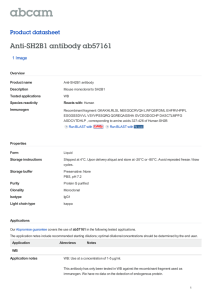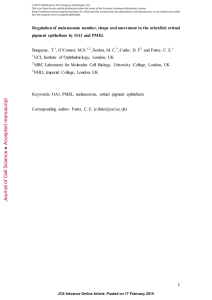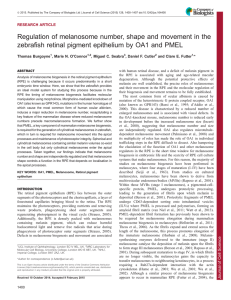Anti-14-3-3 antibody ab14112 Product datasheet 6 References Overview
advertisement
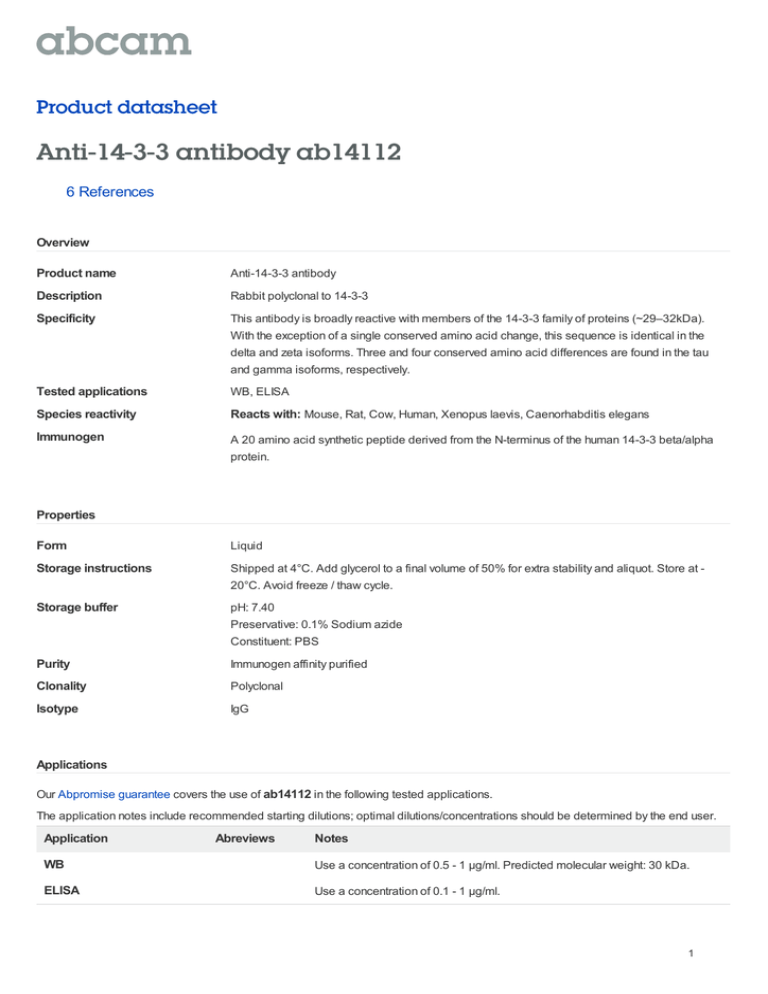
Product datasheet Anti-14-3-3 antibody ab14112 6 References Overview Product name Anti-14-3-3 antibody Description Rabbit polyclonal to 14-3-3 Specificity This antibody is broadly reactive with members of the 14-3-3 family of proteins (~29–32kDa). With the exception of a single conserved amino acid change, this sequence is identical in the delta and zeta isoforms. Three and four conserved amino acid differences are found in the tau and gamma isoforms, respectively. Tested applications WB, ELISA Species reactivity Reacts with: Mouse, Rat, Cow, Human, Xenopus laevis, Caenorhabditis elegans Immunogen A 20 amino acid synthetic peptide derived from the N-terminus of the human 14-3-3 beta/alpha protein. Properties Form Liquid Storage instructions Shipped at 4°C. Add glycerol to a final volume of 50% for extra stability and aliquot. Store at 20°C. Avoid freeze / thaw cycle. Storage buffer pH: 7.40 Preservative: 0.1% Sodium azide Constituent: PBS Purity Immunogen affinity purified Clonality Polyclonal Isotype IgG Applications Our Abpromise guarantee covers the use of ab14112 in the following tested applications. The application notes include recommended starting dilutions; optimal dilutions/concentrations should be determined by the end user. Application Abreviews Notes WB Use a concentration of 0.5 - 1 µg/ml. Predicted molecular weight: 30 kDa. ELISA Use a concentration of 0.1 - 1 µg/ml. 1 Target Function Adapter protein implicated in the regulation of a large spectrum of both general and specialized signaling pathways. Binds to a large number of partners, usually by recognition of a phosphoserine or phosphothreonine motif. Binding generally results in the modulation of the activity of the binding partner. Negative regulator of osteogenesis. Blocks the nuclear translocation of the phosphorylated form (by AKT1) of SRPK2 and antagonizes its stimulatory effect on cyclin D1 expression resulting in blockage of neuronal apoptosis elicited by SRPK2. Sequence similarities Belongs to the 14-3-3 family. Post-translational modifications The alpha, brain-specific form differs from the beta form in being phosphorylated (By similarity). Phosphorylated on Ser-60 by protein kinase C delta type catalytic subunit in a sphingosinedependent fashion. Isoform Short contains a N-acetylmethionine at position 1. Cellular localization Cytoplasm. Melanosome. Identified by mass spectrometry in melanosome fractions from stage I to stage IV. Please note: All products are "FOR RESEARCH USE ONLY AND ARE NOT INTENDED FOR DIAGNOSTIC OR THERAPEUTIC USE" Our Abpromise to you: Quality guaranteed and expert technical support Replacement or refund for products not performing as stated on the datasheet Valid for 12 months from date of delivery Response to your inquiry within 24 hours We provide support in Chinese, English, French, German, Japanese and Spanish Extensive multi-media technical resources to help you We investigate all quality concerns to ensure our products perform to the highest standards If the product does not perform as described on this datasheet, we will offer a refund or replacement. For full details of the Abpromise, please visit http://www.abcam.com/abpromise or contact our technical team. Terms and conditions Guarantee only valid for products bought direct from Abcam or one of our authorized distributors 2
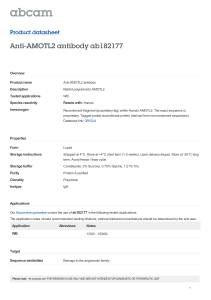
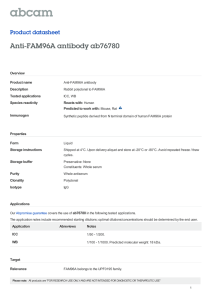
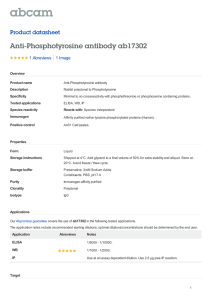
![Anti-MAP2 antibody [AA6] ab24645 Product datasheet](http://s2.studylib.net/store/data/012561464_1-65e9eeb2db798bbc5a298da418116620-300x300.png)
![Anti-Phosphoserine antibody [3C171] ab17465 Product datasheet 1 Abreviews 2 Images](http://s2.studylib.net/store/data/012661843_1-cf30f7cdd8fba511ca130702d73e7f10-300x300.png)
![Anti-LAT2 antibody [8B12] ab123896 Product datasheet 2 Images Overview](http://s2.studylib.net/store/data/012704276_1-744734a929e8d4e01a96fbe5b679f2ff-300x300.png)
